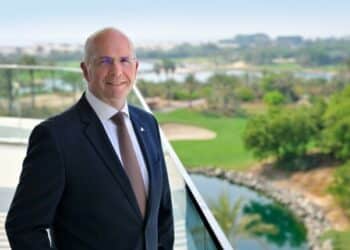Despite grappling with the challenges of political instability in North Africa, Morocco is on track to develop its Vision 2020 tourism plan of becoming a top 20-destination by 2020. The tourism and hospitality sector already contributes 12% of GDP and supports around 505,000 direct jobs within the industry. Here, Hotel News ME analyses how the region can capitalise on domestic tourism, drive revenue through enhancing its pristine coastline with beach resorts and how expanding air-links will help diversify its customer base. 
Situated on the western tip of North Africa, Morocco – also knownHilton Taghazout Bay Beach R by its ancient name Al Maghreb, meaning “the West” in Arabic – contains a mix of indigenous Berber, Arab, African and European influences. Most of its 33 million people live near the northern plains and cities along the Atlantic coast and speak Arabic, French or one of the varieties of Berber. As the region’s only monarchy, the kingdom has fashioned its rich cultural heritage into a tolerant state, whose pragmatic and inclusive approach to social and economic development has allowed it to sidestep the instability that has shaken some of its neighbours in recent years. A spate of modest political and governmental reforms, alongside a rapidly improving business environment, has allowed the country to expand its influence both in the Mediterranean basin and more broadly on the African continent.
The big vision
A key component of Vision 2020, the national tourism strategy that aims to attract 20 million visitors by the end of the decade, domestic tourists are now seen as one of Morocco’s most reliable source markets in the face of volatile foreign arrivals and uncertainty associated with current regional instability. One testament to this is the Ministry of Tourism’s latest figures, which show Moroccan tourists spent 5.3m nights in the country’s classified accommodations in 2014, up from 2.27m in 2000. This makes them the largest source market by this measure, accounting for a 27% share, with authorities hoping to raise this to 40% by 2020.
Recent years have seen Morocco grapple with multiple difficulties, from the Eurozone crisis in Europe to regional instability in the wake of the Arab Spring in Tunisia, Libya and Egypt. The country was also preparing to host the Africa Cup of Nations in January 2015, but lost its host status following the Ebola outbreak. Yet amid such challenging times, the country still aspires to become a top 20 tourism destination by 2020, motivated by the ambitious goals set out in the framework of its national tourism development plan, Vision 2020.
Succeeding Vision 2010, Vision 2020 aims at attracting 20m visitors, boosting tourism revenues to $15.2bn and expanding hotel bed capacity to 375,000, all by the end of the decade. While the sector did not achieve all of the objectives outlined in Vision 2010 on time, it has nonetheless made significant strides in improving certain indicators. Arrival numbers, for instance, more than doubled between 2000 and 2010, rising from 4.27m tourists to 9.28m and far outpacing nearby Tunisia, where visitor numbers increased from 5.05m to 6.9m over the same period.
Performance
Some 10.3m tourists visited Morocco in 2014, representing a 2.4% increase over 2013. In terms of arrivals, the country fared relatively well compared to neighbouring Tunisia which saw a decline of 3.2% according to BMI Research; however, the growth rate was slower than in 2013, when visitor numbers rose 7% Y-o-Y.
The total number of nights spent in the country’s classified accommodation also grew by just 3% in 2014 after increasing 9% a year earlier. This decline can be attributed to a number of exogenous factors, including the protracted economic recession in Europe – Morocco’s main source market for foreign visitors as well as a continued perception of risk for North Africa as a whole. “Growth rates in 2014 took off with a promising start,” Adnane Jelb, head of the service studies and strategic monitoring department at the Ministry of Tourism, Morocco, explains: “However, as of the third quarter the sector witnessed a slowdown due to a number of destabilising events occurring elsewhere in the region, such as the assassination of French citizen Hervé Gourdel in neighbouring Algeria, impacting arrivals from certain markets and to certain destinations”, he adds.
Relating to domestic tourist numbers, Jelb explains: “Moroccans residing abroad accounted for 47% of visitors in 2015, while the rest came from diverse nationalities: The French made up 17% of arrivals, followed by the Spanish at 7% and the British only at 5%. The bulk of tourists from abroad – 6.94 million, or 68% of foreign visitors arrived by air, with Casablanca’s Mohammed V Airport welcoming 2.28 million tourists, followed by Marrakech’s Menara Airport with 2.12 million.”
Key markets
The French market is still the single largest source of visitors to the region in 2016, and has progressed slowly over the past five years, with their numbers growing by an average annual rate of 1%. Such growth rates are not unique to Morocco, but rather reflect a general trend among French travellers whose spending power has been curtailed by the economic downturn in Europe, and whose concerns about travelling to the North Africa region have increased since 2011.
What has changed, however, are the categories of French people who visit says Jelb: “The number of returning French tourists to Morocco is on the rise, as opposed to first-time visitors. These tourists are accustomed to the country and return to discover the culture at their own convenience, often residing in rented apartments and sometimes even acquiring property.”
Another developing trend is online reservations, whereby tourists are directly involved in arranging their own flight and accommodation. This marks an important shift from a long tradition of package tours or bookings through travel agents. The quest for good deals in conditions of tighter spending has also seen the number of last-minute reservations increase in recent years, impacting both revenues and visibility.
To offset the slowing arrival numbers from France, Morocco has sought to diversify its source markets over the past four years, attracting more visitors particularly from the UK, Spain and Germany. In 2015, 476,550 British tourists visited Morocco, an 18% Y-O-Y growth, and the country aims to raise this to one million over the course of the next three years.
This increase comes on the back of efforts carried out by the Moroccan National Tourism Office (ONMT) to promote the country abroad. The addition of new air links, motivated by the open sky agreement signed in 2006, has also bolstered visitor numbers, particularly from Spain, which in 2015 placed second after France by number of arrivals and accounted for 7% of the total visitors.
Promotion
The instability that ensued from the Arab Spring and incidents in Algeria have affected the international perception of the region as a whole, dragging down growth in Morocco despite the region’s comparative stability as Jelb insists: “We need to enhance communication in order to differentiate ourselves as a country from what is happening elsewhere in the region. Agadir, for instance, offers favourable weather conditions throughout the year and has the potential to be a year-round destination.”
Any attempt to expand Morocco’s promotional campaigns will of course depend on its capacity to diversify its actual offerings, such as its slowly gestating seaside resort development plan, Plan Azur. But even apart from developing new attractions, the country’s promotional efforts have faced challenges in attracting sufficient funding. “The ONMT’s budget accounts for 0.54% of total revenues generated by the country, while that of neighbouring countries hovers between 2.2% and 2.5%,” explains Jelb.
Plan Azur
Morocco has a coastline of more than 3500 km bordering both the Atlantic Ocean and the Mediterranean Sea, yet the country’s seaside tourism segment remains shy of its potential. Even Agadir – which had the second-highest number of tourist nights spent in-country in 2015 after Marrakech, at 5.05 million nights – is running below capacity, hindering its competitiveness as a destination and limiting its chances of being marketed by tour operators. “A minimum of 60,000 available beds are required to attract a tour operator, but Agadir today runs with just 30,000 beds,” according to Jelb.
Under Vision 2010, Plan Azur was devised to develop six seaside resorts: Saidia in Berkane, Lixus in Larache, Mazagan in El Jadida, Mogador in Essaouira, Taghazout in Agadir and Plage Blanche in Guelmim. The projects have, however, been held up by a number of obstacles related to financing, management and marketing, thus limiting the ONMT’s efforts to promote seaside offerings abroad.
Resorts
Nonetheless, several resorts have made some headway since. Saidia, the plan’s first resort to open in 2009, and located in the north-east near the border with Algeria, today has three operational hotels, with a fourth to be added at the end of 2016 boasting 3,000 rooms, though 1,200 of these have not been in use since October 2013, after Atlas Hospitality, the company managing the Oriental Bay Beach hotel, left the resort due to the non-attainment of objectives set when it took on its contract.
Mazagan, also inaugurated in 2009, and located on the Atlantic coast about 80 km south-west of Casablanca, has a capacity of 500 rooms in addition to a golf course and casino. Two more phases have yet to be reached to achieve the resort’s goals of 8,000 rooms and two golf courses, estimated at a total cost of $1.2bn.
Works on the Taghazout resort in the south-west opened its first hotel in 2015, with the project valued at around €1.1bn with a total of 12,000 rooms. Of the 10,000 beds planned for the Mogador resort in the south-west, 500 have been delivered so far, as well as a golf course. Lixus, in the north, which is expected to generate $326 million in investment according to the tourism board, will eventually comprise of five hotels and a golf course. Finally, Oued Chbika, in the south-west, has yet to take off with 30,000 planned rooms.
These resorts under Plan Azur will be crucial in increasing revenue from the country’s seaside assets. Boosting seaside tourism is also key to extending tourists’ average length of stay, which is currently just 3.6 days. Tour operators, which attract around 20% of visitors to Morocco, will be key in ensuring the success of these resorts by bringing in foreign tourists. The lack of a seaside offering has held back their share of visitor numbers, while recent expansion in air connectivity has also led low-cost flights to outpace charter flights.
Marrakesh
Between 2000 and 2014, arrival numbers to Marrakech airport rose from 591,142 to 2.12 million, while the city’s bed capacity increased from 18,696 to 65,640, partly due to heightened investment in the city’s infrastructure and an aggressive promotional campaign. Today, Marrakech accounts for the largest number of nights spent in-country, with 6.72 million nights in 2015, up from 3.78 million in 2000. “Marrakech performed remarkably well in 2015, offsetting the delay witnessed by Plan Azur. Arrivals increased by 9% in 2014, accounting for 21% of total arrivals to the country. One reason for this growth was that some trips to certain remote areas – such as Ouarzazate, for which arrivals fell 2% in 2014 were substituted for places like Marrakech due to the slower demand caused by widespread concerns over regional risk,” explains Jelb.
City breaks
Works currently being carried out in numerous Moroccan cities like Casablanca, Rabat and Tangiers should help a new form of tourism offering to emerge. The so-called city-break – a short holiday spent in a city like Casablanca or Rabat – is being promoted through a number of projects in a bid to boost travellers’ length of stay. While Marrakech has proved a success, other Moroccan cities are still seeing very modest visitor numbers. The number of nights spent in Casablanca, for example, increased from 1.13 million, nights in 2000 to just 1.89 million nights in 2014, while in Tangiers the figure went from 612,638 to 932,777 during the same period.
To raise these numbers further, several projects have been launched in recent years with the aim of generating more entertainment and leisure offerings in various cities, ranging from the development of museums and theatres to enhancing architecture and building new shopping malls. In Casablanca for instance, an estimated $1.1bn is expected to be spent as part of a state-backed programme to develop 46 projects in the greater Casablanca region, including the city’s marina, a tourism fishing port and a cruise ship port.
A second project called Wessal Bouregreg, launched in 2014 in the Bouregreg valley in Rabat to develop cultural and tourism offerings in the Moroccan capital, will include hotels and other attractions – namely a marina, a shopping centre and a 2000-seat theatre. The project will run through to 2020 and is expected to mobilise up to $979 million in revenue.
Flight connectivity
Air links have expanded significantly, particularly since an open sky agreement was signed in 2006, allowing low-cost airlines such as EasyJet and Ryanair to penetrate the market. Nonetheless, further links need to be developed if the country is to reach its goal of 20 million tourists by 2020. Flights from Berlin to Marrakech, for instance, are carried out just twice a week, and those coming from the UK outside of the big cities like London and Manchester are limited.
While Royal Air Maroc flies directly to New York, further development of long-haul flights, in line with the country’s ambitions to attract tourists from countries like China and Brazil, would help accelerate growth, but for now, the types of flight that serve the country need adjusting to provide a more equitable flow of tourists and revenues says Jelb, “In addition to increasing air links towards certain destinations, a balance needs to be achieved between regular, charter and low-cost flights, which will help diversify the customer base. The expansion in the number of low-cost flights landing in Marrakech, for instance, has certainly contributed to boosting arrival numbers, but on the downside it has impacted revenues and length of stay.”
Outlook
Though arrival numbers fell shy of the country’s goal of 10.7m in 2015, Morocco fared well by regional standards, demonstrating its resilience to the instability that has struck most of the Arab world in recent years. The challenge that lies ahead, however, is partly how to convey this image of a stable and secure destination. The decision to postpone the Africa Cup of Nations following the Ebola outbreak should certainly back the country’s efforts to promote itself as a risk-free destination. As projects outlined in Plan Azur come in-line, they will help unlock potential in markets like the UK and Germany, which have long sought bargains and package holidays in the southern Mediterranean. To ensure that this continues apace, developing partnerships with foreign tour operators will be crucial. In diversifying the country’s customer base, not only does dependence on France as the main source market need to be reduced, but just as important, capitalising on the domestic market will be a necessary hedge against volatile tourist arrivals and looming uncertainty.



































































